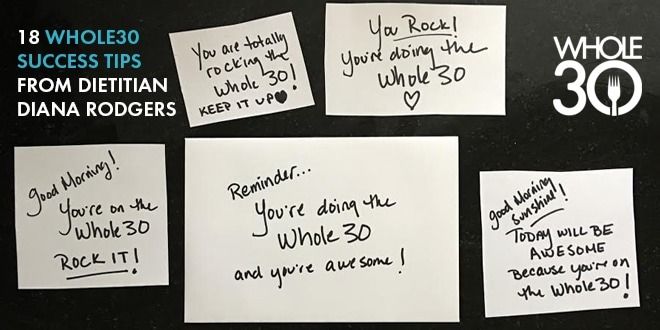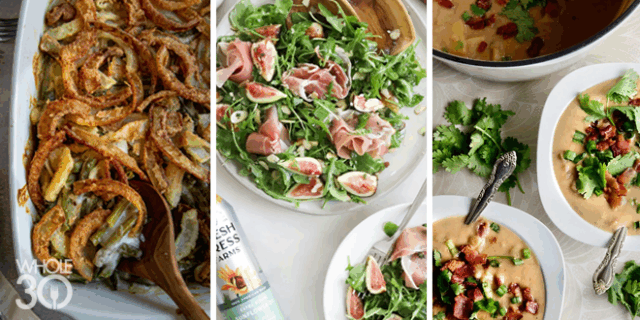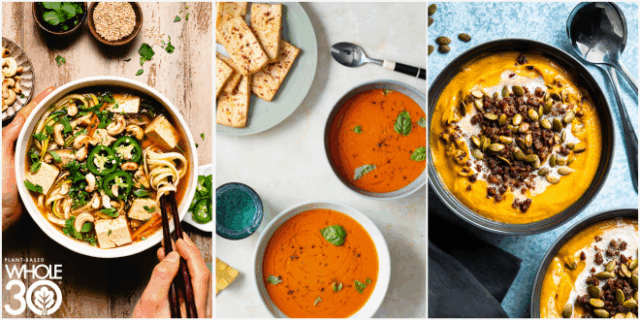by Whole30 advisor Diana Rodgers, R.D.
Hey Whole30’er! Diana here. I’m a registered dietitian, the writer behind the blog Sustainable Dish, and a Whole30 Certified Coach. I’ve guided hundreds of people through the Whole30 program and have learned a thing or two along the way. There are certain behaviors that can really help you succeed on your journey, and I’m so excited to share them with you.
Food
1. Eat Enough Protein I notice that when folks cut out their morning toast, they forget to double up on their eggs. Most people are not eating enough protein. This post on my site explains this in depth. If you aim for at least 20% of your calories from protein on a 2,000 calorie diet, that’s 100 grams. This means 4-6oz of eggs, fish, red meat or poultry at each meal. Animal protein is incredibly satiating, and full of easily absorbed vitamins and minerals. (Don’t confuse grams of protein with weight of meat, these are different values.)
2. Don’t Go Nuts When people complain to me that they’re not seeing the results they hoped for on their Whole30, it’s nearly always because they’re overeating that 5lb bag of almonds or binging on almond butter. Now, we’re not counting calories here, but if you’re eating a cup of almond butter each day, you’re adding nearly 1600 calories to your day.
3. Take it Easy on Fruit On a Whole30, you’re trying to change your relationship with food and for many, this means turning off your sweet tooth. Swapping candy for multiple servings of fruit a day will not help you break your sugar addiction. Fruit is sugar. Dried fruit is even more concentrated sugar. Keep your fruit intake to one or two servings a day.
4. Make Really Fun Salads I hate to break it to you, but lettuce is pretty much just crunchy water. It’s not a nutrient-dense food but, what you add to you salad can be. Fill your bowl with colorful vegetables, pepitas or sunflower seeds, sprouts, and even some fruit. And don’t forget to add lots of protein (a can of tuna or salmon, for example) and healthy fats (such as avocado).
5. Avoid Drinking Your Meals Although smoothies are technically allowed, I am not a fan of drinking calories. Science shows that your brain’s normal satiety signals are bypassed when you gulp instead of chew. This means, people don’t account for those calories later in the day, and end up eating more. Do yourself a favor, wake up five minutes earlier and make yourself some eggs or reheat some leftovers instead of bringing a smoothie along for your commute.
6. Eat More Soup Counter to drinking meals from a cup, which tend to be full of sugars and mindlessly consumed, soup has been shown to be incredibly satiating. I love soup because you can make a ton of it, it’s a great way to extend food, it’s inexpensive, bone broth is a superfood, and you can pack a ton of vegetables into every bite.
7. Sip on Herbal Teas Non-caffeinated teas are a fun way to experience different tastes without eating garbage. Buy a tea sampler and instead of mid-meal snacks, drink some tea instead. Some of my favorite flavors are peppermint, rooibos, rosehip, lemon balm, and ginger.
8. Sit Longer with Your Food Sit down, relax, and appreciate your meal. Rushing to get the food down and watching TV while surfing Facebook is not going to help you change your relationship with food. Have a conversation with someone instead of staring at a screen. Give yourself a full 20 minutes to let your brain’s satiety signals kick in before you rush up for seconds.
9. Eat Enough If you find that you’re dying for lunch at 10am, or wishing you had a candy bar at 4 in the afternoon, it’s likely because you didn’t eat enough at breakfast or lunch. Many time when people eliminate grains from their diet, they forget to add in MORE FOOD. I see this most often with breakfast. If you used to have one egg and two slices of toast, don’t just eliminate the toast and think one egg will last you till lunch. Bump that up to 3 eggs! Remember that grains really extend food, so it’s a good idea to cook more than you think you’ll need. This way, you’ll always have a healthy “mini meal snack” on hand if you did misjudge and eat too little for breakfast or lunch.
Meal Planning
10. Keep it Simple I know there are tons of really gourmet recipes out there that can make Whole30 meals look incredible. That’s awesome but in the beginning, I’ve noticed people can get really overwhelmed with the increase in kitchen time and the new way of eating. For the first week or so, I usually suggest that folks keep it pretty basic. This could be: three egg omelette with veggies for breakfast; huge salad with 4-6 oz of salmon (or protein of your choice) and some avocado for lunch; and for dinner eat a sweet potato, green vegetable and another 4-6oz of protein. Make it really easy until you get the hang of it, then branch out to gourmet recipes.
11. Cook in Bulk While you’ve got that oven on, why not fill it up? It’s no more effort to toss in a second chicken to roast, add more root veggies to the pan, and make your life 80% easier by not having to cook dinner tomorrow night. The same goes for batch cooking a pot of chili, soup, etc. You can eat the leftovers for lunch or freeze them for later. I happen to only cook a few nights a week, but eat 90% of my meals at home.
12. Get an InstaPot This sucker has changed my life. It’s a slow cooker on steroids. If you haven’t jumped on the bandwagon yet, do it now. For people who cook from scratch, an Instapot is a must have. I use mine more than once a week! Already have one? Check out Nom Nom Paleo’s roundup of Instant Pot recipes.
13. Stock up on Emergency Rations While you should be eating enough at each meal in order to make it to your next, sometimes we can be caught off guard with unexpected hunger. Make sure you’re prepared. Put a few cans of tuna, pouches of coconut chips, beef jerky or EPIC bars in your car or desk drawer so you have no excuses to reach for a “mistake.” Check out the Whole30 compatible collection at Barefoot Provisions for more options.
14. Join Real Plans Did you know Whole30 has a great partnership with Real Plans? This isn’t just a list of static recipes. You can completely customize it so that you’re only getting food you’d actually make. Don’t like green peppers and mushrooms? No problem! You log on, set your diet preferences and quantities, and Real Plans serves you up recipe suggestions and a shopping list. You can even get recipes from your (and my) favorite Whole30 friendly authors like Nom Nom Paleo and Melissa Joulwan.
15. Group Meals Get a meal club going where you all share the cooking tasks. One person makes a batch of chicken hash, another makes a few egg and spinach frittatas, and you tackle the pulled pork carnitas. This way, you get more variety with less stress.
Dining Out, Travel, and Socializing
16. Order First at the Restaurant, No Regrets When you go out to eat, pick a healthy option and then put the menu down. When you stare at the menu, you can easily second guess yourself, and it can trigger you to veer off course. People also change their minds when they see or hear what others have ordered. Be firm and stay committed to your Whole30. Be the first to order and feel great about what you ordered.
17. Eat Before You Go to the Party Have a full stomach before you go out, or bring something along that you know is a good choice so you don’t find yourself starving without a Whole30 option.
18. Swap Your Hotel for AirBnb Traveling can often be one of the biggest reasons why people fail on their Whole30. I nearly always stay in an Airbnb (or similar apartment/housing rental site) when I travel. It’s usually the same price or less expensive than a hotel, you get more space (ideal for families) and you get a kitchen. It’s also fun because you can get a much better sense of what it’s like to live in the place you’re visiting. I’ll usually hit a grocery store to get provisions for breakfasts and a couple of dinners, and then enjoy a few meals out.















